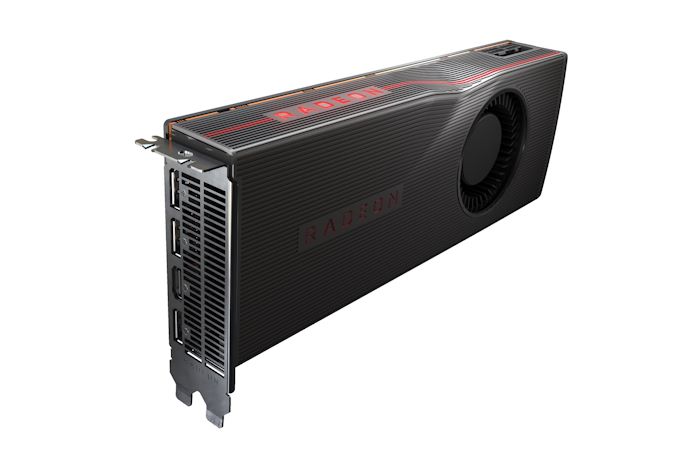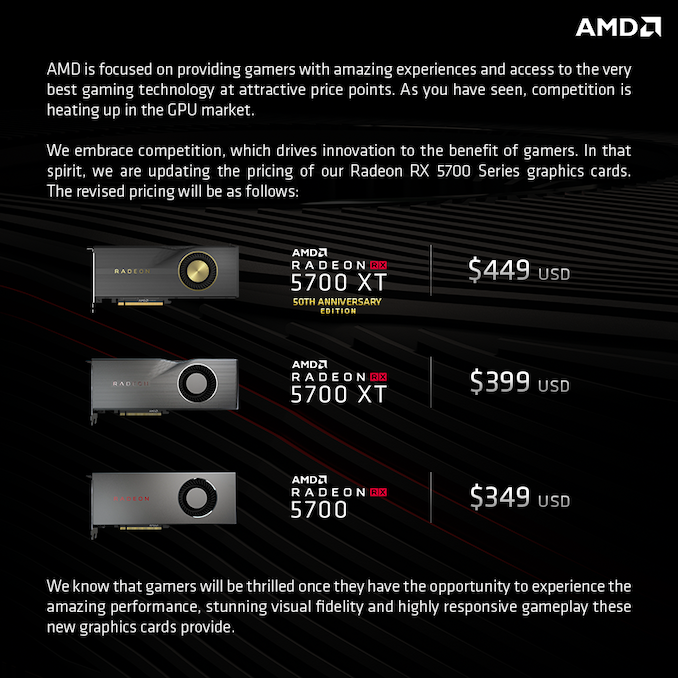AMD Adjusts Launch Price of Radeon RX 5700 Series: XT Down To $399, Standard Down To $349
by Andrei Frumusanu on July 5, 2019 5:30 PM EST- Posted in
- AMD
- GPUs
- Navi
- Radeon RX 5700

The new Radeon RX 5700 hasn’t even yet officially launched as we’re still awaiting Sunday the 7th of July, yet AMD in a rare event has now officially announced that is it adjusting the launch prices of the new Navi cards to lower price points.
Originally, the Radeon 5700 XT Anniversary edition, the XT, and the standard variant were priced at $499, $449, and $379. AMD has now lowered the price points to $449, $399 and $349.
| AMD Radeon RX Series Specification Comparison | ||||||
| AMD Radeon RX 5700 XT | AMD Radeon RX 5700 | AMD Radeon RX 590 | AMD Radeon RX 570 | |||
| Stream Processors | 2560 (40 CUs) |
2304 (36 CUs) |
2304 (36 CUs) |
2048 (32 CUs) |
||
| Texture Units | 160 | 144 | 144 | 128 | ||
| ROPs | 64 | 64 | 32 | 32 | ||
| Base Clock | 1605MHz | 1465MHz | 1469MHz | 1168MHz | ||
| Game Clock | 1755MHz | 1625MHz | N/A | N/A | ||
| Boost Clock | 1905MHz | 1725MHz | 1545MHz | 1244MHz | ||
| Throughput (FP32) | 9.75 TFLOPs | 7.9 TFLOPs | 7.1 TFLOPs | 5.1 TFLOPs | ||
| Memory Clock | 14 Gbps GDDR6 | 14 Gbps GDDR6 | 8 Gbps GDDR5 | 7 Gbps GDDR5 | ||
| Memory Bus Width | 256-bit | 256-bit | 256-bit | 256-bit | ||
| VRAM | 8GB | 8GB | 8GB | 4GB | ||
| Transistor Count | 10.3B | 10.3B | 5.7B | 5.7B | ||
| Typical Board Power | 225W | 180W | 225W | 150W | ||
| Manufacturing Process | TSMC 7nm | TSMC 7nm | GloFo/Samsung 12nm | GloFo 14nm | ||
| Architecture | RDNA (1) | RDNA (1) | GCN 4 | GCN 4 | ||
| GPU | Navi 10 | Navi 10 | Polaris 30 | Polaris 10 | ||
| Launch Date | 07/07/2019 | 07/07/2019 | 11/15/2018 | 08/04/2016 | ||
| Launch Price | $399 |
$349 |
$279 |
$179 |
||
The move isn’t unprecedented, but is something extremely rare. What is interesting is that AMD’s Scott Herkelman (CVP & GM AMD Radeon) yesterday posted an interesting but short tweet:
Jebaited
— Scott Herkelman (@sherkelman) July 4, 2019
Scott's snarky tweet is suggesting AMD had planned the move all along- playing a bait & switch in terms of the pricing of the RX 5700, most likely in preparation and in response to Nvidia’s newest Super card line-up.
We’re looking forward to covering the RX 5700 series cards when the time comes – hopefully soon!
Related Reading
Source: @Radeon on Twitter











78 Comments
View All Comments
Maxiking - Sunday, July 7, 2019 - link
Expected, no raytracing, cheap and loud blower fans, what are we, in 2014? It will also mean limited oveclocking ability, no Gsync and that final nail into the coffin is that Freesync also runs on Nvidia.One must be dense to buy an amd gpu. Or a fan. Sadly, this is a causal relationship.
Korguz - Sunday, July 7, 2019 - link
no Gsync ??? NO big loss, that COSTS you some cash in the monitor. upping the price... freesync.. is just that.. free.. and part of the reason why nvidia now supports it.. is because few were buying gsync monitors ...and one must be denser to by an overprices nvidia gpu, or have more money then brains
Korguz - Sunday, July 7, 2019 - link
oh also " cheap and loud blower fans, " thats why most people will wait till the custom cooling cards come out ...saiga6360 - Sunday, July 7, 2019 - link
Exactly. So the simplest way for the masses to know AMD is just fine is that despite Nvidia's dominance, they are still in the GPU business.It's really funny how some of us mere mortals are that worried about these corporations making enough money.
NewCPUorder - Monday, July 8, 2019 - link
Anandtech didn't want to put to specifications table PCIe 4.0 mention? What is the reason? Sandbagging AMD products again?Korguz - Tuesday, July 9, 2019 - link
huh???MASSAMKULABOX - Wednesday, July 10, 2019 - link
Pcie 4.0 wont make a diff to gfx cards for some number of years..AndrewIntel - Sunday, July 10, 2022 - link
this solution is based on a 12 inch wafer and in the future the industry will move to 18 inch wafers, which means higher utilization of the fab and better pricing per wafer and eventually better prices to the end user. This die per wafer calculator show the various options per wafer size: https://anysilicon.com/die-per-wafer-formula-free-...